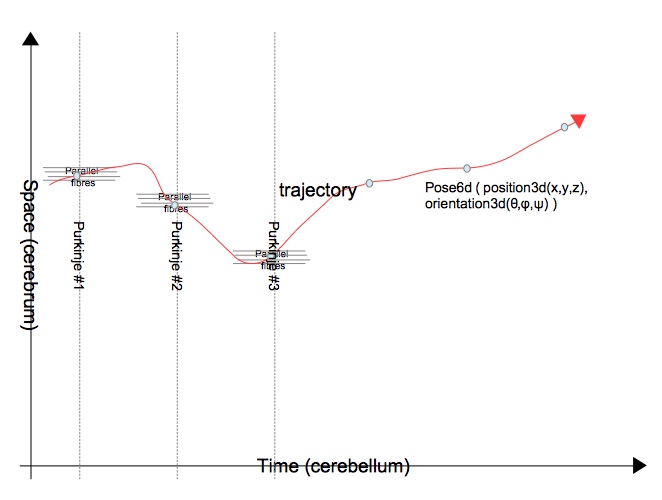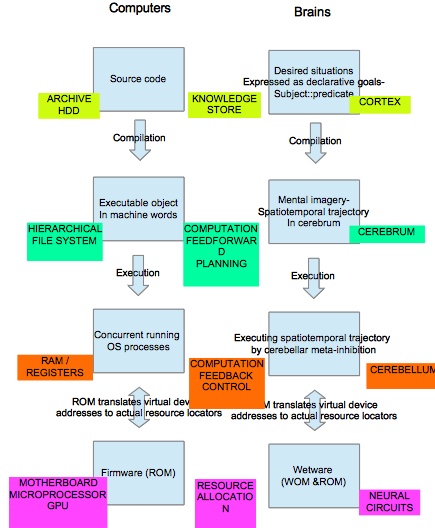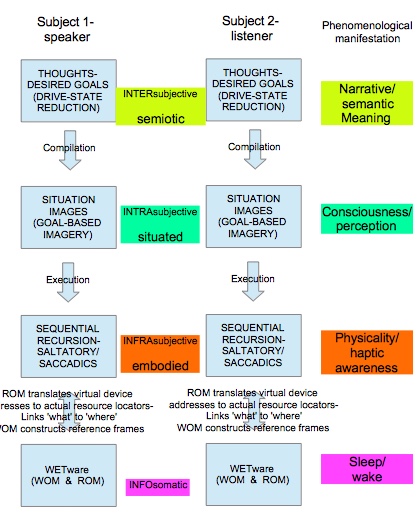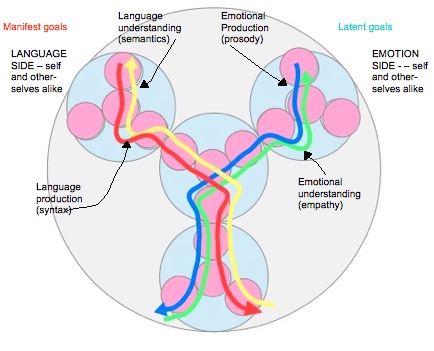Brains of Sand 5 A Model of the Cerebellum
It seems to be necessary for the inventor of each new MOM (model of mind) to test their theory by using it to construct a plausible account of the cerebellum. Two notable models of cerebellar function are those of Marr and Albus. The TDE account of cerebellar function is inextricably tied in with that of the cerebrum. They are inseparable, a neurocognitive double act- one cannot be understood without the other.
The cortex contains a semantic (knowledge-based) model of the organisms environment. The cerebrum contains a representation of planned behaviour derived from this semantic model (see figure 2.3). This representation closely resembles modern computer animation practice, in that it represents behavioural plans as a series of sequential postural keyframes. The cerebellum executes the behavioural plan in a saltatory manner. That is, each time the climbing or c-fibre (which has a 1:1 relationship with each p-cell) fires, the p-cell also fires.
The p-cell has a meta-inhibitory action on the 'job queue' in the basal ganglia. Each time it fires, it inhibits the inhibitor cells, causing net excitation ('releasing the brakes') in the dopaminergic basal ganglia. This triggers a transition in the Moore machine from the current state (postural keyframe) to the next state. The brain uses cybernetic methods of operation at this level. When the keyframe transition occurs, it is akin to changing the setpoint value in a homeostat. The position frame moves, and the forces required to implement this move are generated internally and locally. No precomputation of force magnitudes is ever performed. This interpretation constitutes a new theory of commanded movement, discovered by this author (and independently by Feldman).
This theory of cerebellar function has an interesting corollary. At the top level, a declarative (semantic goal-based) task representation in the cerebrum is converted into a procedural one in the cerebellum. However, precisely the same type of process occurs in all computer programming. It is called 'compilation'. This theory therefore supports in a very 'deep' way the assertion that brains are computers.
Previous theories of cerebellar function have only achieved a partial fit with observations. I believe that the reason for this is the failure of the researchers to understand the true cybernetic nature of the brain and mind. Indeed, the very meaning of the term 'cybernetic' has been smeared and diluted over time. Its current meaning as a general adjective for electronic and digital systems bears little semblance to its original, highly specific one. Arguably, if cybernetics had retained its original character as a specific technical domain, cognitive neuroscience might not have lost its way.
Without understanding the exact meaning of cybernetic terms such as homeostat, and servostat, and their true potential as system building elements, the architecture of the brain (generally) and the cerebellum (specifically) makes no overall sense, in that, we cannot link causes to effects, subjective agency to behavioural observations. It is precisely these linkages, often disparagingly referred to as 'teleology' by those who fail to grasp their real importance, which form the foundations of a truly scientific understanding of the brain and mind.
*Anatol Feldman refers to the theory as 'referent frame' // 'equilibrium point' control.
It is widely believed that the cerebrum ('the motor cortex') controls body movement directly. This is the implicit belief behind the naming of the orbito-frontal and frontal lobes as the 'pre-motor' and 'motor' areas respectively. This belief is not so much false as misleading. While it is true that cortical activity in the frontal lobes is often accompanied by motion in the contralateral half of the body, the true relationship is considerably more nuanced and complex than current thinking suggests. For example, there can be cortical activity in the motor cortex without any body motion at all, during acts of focussed mental imagery. Without connecting the cerebral spatial model to the cerebellar temporal profile, guided body motion cannot occur.
The relationship is not one of direct causality. Rather, the cerebrum is a spatial modeller of the environment ('world') surrounding each subject. It is not the cerebrum which controls motion directly, but the cerebellum (and basal ganglia). Conventionally, the relationship between cerebrum and cerebellum is imagined as resembling that between an automobile's engine and its transmission (eg clutch and gear train). The term 'coprocessor' is sometimes applied to the cerebellum in this context, implying that the cerebellum ('little brain') is somehow the cerebrum's junior partner.
The true situation is that of a perfectly balanced partnership, in which both cerebrum and cerebellum split Newtonian physics governance tasks*. The cerebrum models the space around a subject. Changes in this space are properly called 'movements'. Movement paths are constructed as 'trajectories'. The cerebellum, however, governs the subject's time**. Changes in bodily configuration along such trajectories are properly called 'motions' (see Figure 9.1).
*19th Century neuroscientists such as Jackson and Herbart were the first to understand this separation of cognitive functionality.
**hence time-based learning modes such as classical conditioning (CC) involve neuroadaptive changes in the cerebellum and basal ganglia (CBG)

Figure 5.1
In the vertebrate brain, movements are constructed using a two-stage process^. First the spatial trajectory is planned in the cerebrum, then the actual body motions needed to create this trajectory are produced in the cerebellum (all vertebrates have equivalent divisions in their brains). The process begins in the limbic (or equivalent) system, which responds to metabolic imperatives, such as thirst, hunger (endogenous) or fear/attraction (exogenous). A contextualised target image (eg of a food item or enemy animal) is retrieved from memory. A matching pattern is then found in the surrounds, going from most general to a more particular meaning, within the equivalent of the Temporal lobe. The subject's position is encoded together with the target's orientation, forming a 6-D data structure called a situation image (resembles the robotic concept of pose).
All animals use an indirect, cybernetic, method of creating motion. The desired spatial position is found, and motion follows automatically by means of a variable thresholded setpoint*. This is none other than classic feedback positioning. Force magnitudes are never computed. In the case of real bodies, each Purkinje cell (together with all the parallel fibres it synapses with) represents a single (multidimensional) stable configuration, ie a unique (head+torso+limbs) posture. Voluntary movements are produced by cybernetic transitions between these posture states**. The cerebellum therefore forms a Finite State Machine called a Moore machine, a synchronous kind of ROM (read-only memory). The P-cell is connected to a sequential pair of inhibitory neural circuits which form a meta-inhibitory brake. When the current P-cell (call it P[i]) is triggered by the climbing fiber (reacts to a positional cue eg saccadic target acquisition) it releases the 'brakes' on the cybernetic motion system, causing the entire posture state to transition from P[i-1] to P[i]. This meta-inhibitory release of inhibitory braking is only just long enough to allow for the transition between successive finite posture states. Note than P-cells act in a feedforward, predictive manner. It is the follower motion which is subsequently caused by restorative feedback action.
*previous models of cerebellar function by Albus, Marr etc fail to understand this point, therefore they are incorrect.
**most likely created during infancy by 'motor babbling'.
^This two-stage tasking scheme, consisting of (a) declarative phase, consisting of human authoring then machine compilation (b) procedural phase consisting of linking objects into target hierarchies (parse tree) which can then be executed, spawning multiple parallel processes. This scenario is familiar to all computer (software) scientists.

Figure 5.2- the computational brain

Figure 5.3- compilation-like brain processes
...

Figure 5.4 - manifest and latent cybernetic goals
